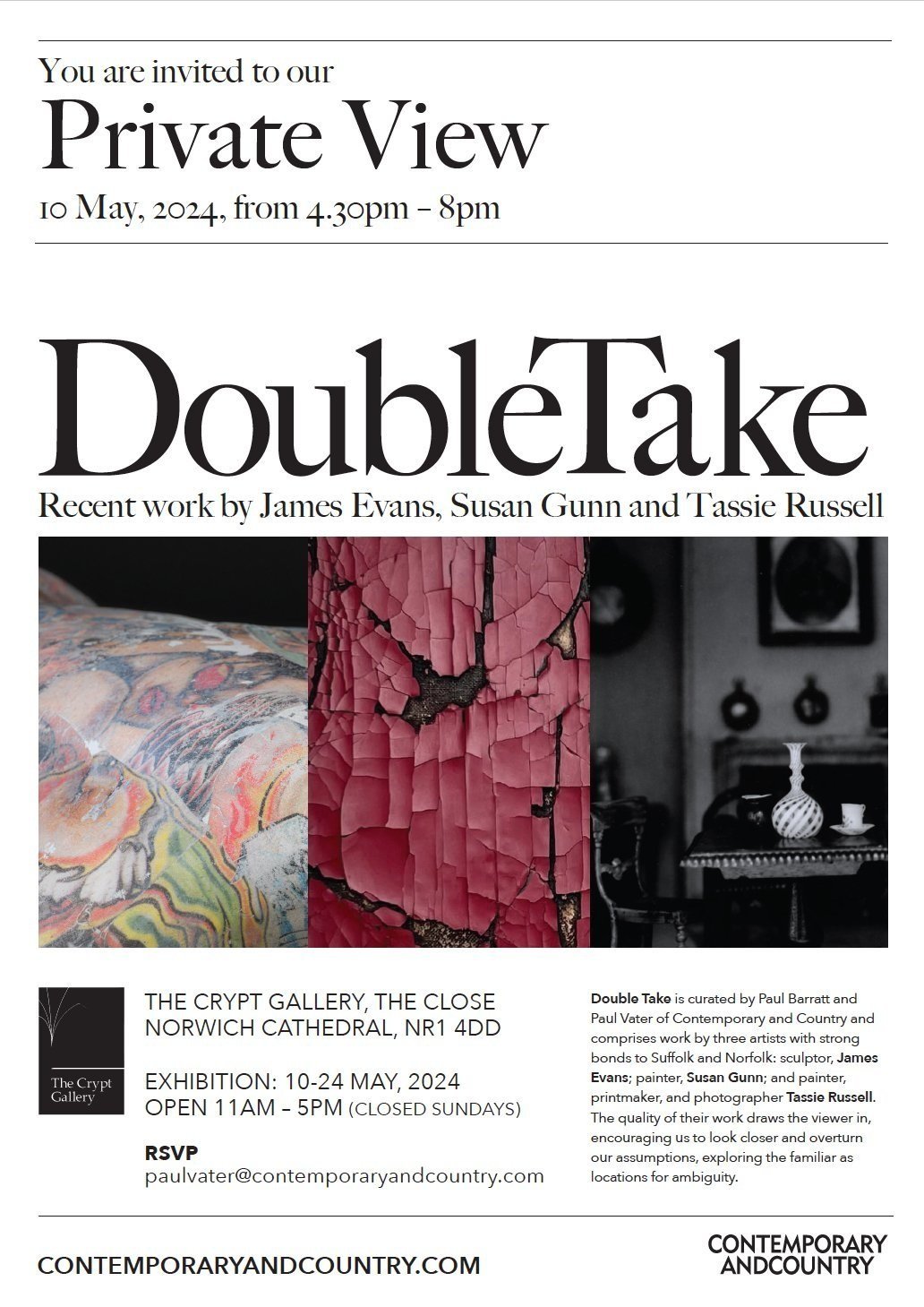Double Take 2024
An exhibition featuring artwork by James Evans, Susan Gunn, and Tassie Russell
10 - 24 May 2024
The Crypt Gallery | Norwich School | Cathedral Close Norwich | Norfolk | NR1 4DD
Preview 10 May 4.30-8pm
Meet the Artists 18 May 2-4pm
RSVP by email paulvater@contemporaryandcountry.com for the above events
Open daily Mon-Fri 11-5pm | Saturday 11-4pm | Closed Sunday
Exhibition further Info: https://www.contemporaryandcountry.com/
“Their work draws the viewer in, encouraging us to look closer…”
James Evans | Susan Gunn | Tassie Russell
The exhibition Double Take comprises new and recent work by three artists: Sculptor, James Evans; painter, Susan Gunn; and painter, printmaker, and photographer Tassie Russell. Their work draws the viewer in, encouraging us to look closer and overturn our assumptions, exploring the familiar as locations for ambiguity.
The idea that there is nothing more deceptive than certainty, is not new. These three artists prove the point using their considerable skills to make accomplished works of art that vacillate between initial appearance and more covert qualities that become evident upon further inquiry.
Susan Gunn
The modernist tradition of the monochrome established by Kazimir Malevich early in the twentieth century turned into a surprisingly rich range of outcomes in art, graphic design, and architecture. The union between the physical canvas and its single colour requires a rigour from the artist, that goes beyond pursuing an austere aesthetic or orthodoxy for the sake of it. Susan Gunn has created surfaces scattered with physical incident in canvas after canvas. Using a variety of techniques that include gesso, and mineral pigments that lay down their surfaces laced with delicate hairline breaks across an otherwise immaculate plain, their apparent fragility creates an emotional resonance for the viewer. In some paintings glints of metallic foil immersed within a colour field, maintain each canvases undeniable intensity, like highly desirable icons. The tension Susan creates between the precise control of her painted surfaces with these moments of vulnerability, set them apart. Her contribution to the lineage of monochromatic painting is assured.
Tassie Russell
Tassie Russell’s photographs could be viewed as a separate body of work. However, the striking large black and white interiors and accompanying smaller colour prints in this exhibition are deceptive both in terms of what they depict, as well as how they inform her work as an established painter and printmaker. The large abstract paintings Tassie is known for are often built around a muted colour palette that reference the way light performs within the modernist interiors she has photographed by architects like Erno Goldfinger. There is a relationship between the different media she uses that moves her observations toward their outcome, as a print, painted canvas or photographic image.
The photographs in Double Take are interiors, but there is something amiss in how they read. The architectural space that fills each frame, does not quite make sense. Unobservant viewers could easily dismiss these beautifully composed images depicting the trappings of an English country house for exactly what they seem. Appearances can be deceptive. The photographs are of a magnificent Georgian Doll’s House. It is a fragile and much-loved plaything as well as family heirloom, that Tassie has been recording as if it were the subject of one of her full-scale photographic projects. Each room is a time capsule of what was ‘of the moment’ in English interiors during the late eighteenth century, reproduced in large black and white prints and smaller, colour prints. The evidential nature of photography ensure we take these sober images at face value. The undertow of doubt undermines their veracity only on closer inspection.
James Evans
James Evans has been navigating variants in his ceramic forms for several decades now. He uses surface textures, glazes, and firing techniques like Saggar to bring incident to folds and hollows in his sculpture. At first glance they could be interpreted as flint, tendon, bone, cast iron, or soft tissue. And yet they are none of these materials. The eye sometimes moves quickly, unhindered by rational thought. The cast iron texture is so convincing James has recently made a series of deeply profiled ceramic tiles for a hotel interior that reference architectural features such as the decorative pressed metal ceiling panels that enhanced early twentieth century interiors across North America.
There are other remarkable deceptions in his tool kit. He has developed transfers applied with such delicacy to the surface of a trunk or torso shape that they read as tattooed skin or a bruised limb. These cadaverous remnants appear frozen in time. Their fragmentary quality hints at recollections of a once much-admired dinner service or the sun-faded catalogue of a tattoo parlour inventory. Memory and its slippage within a narrative is a powerful element of their sculptural appeal.




